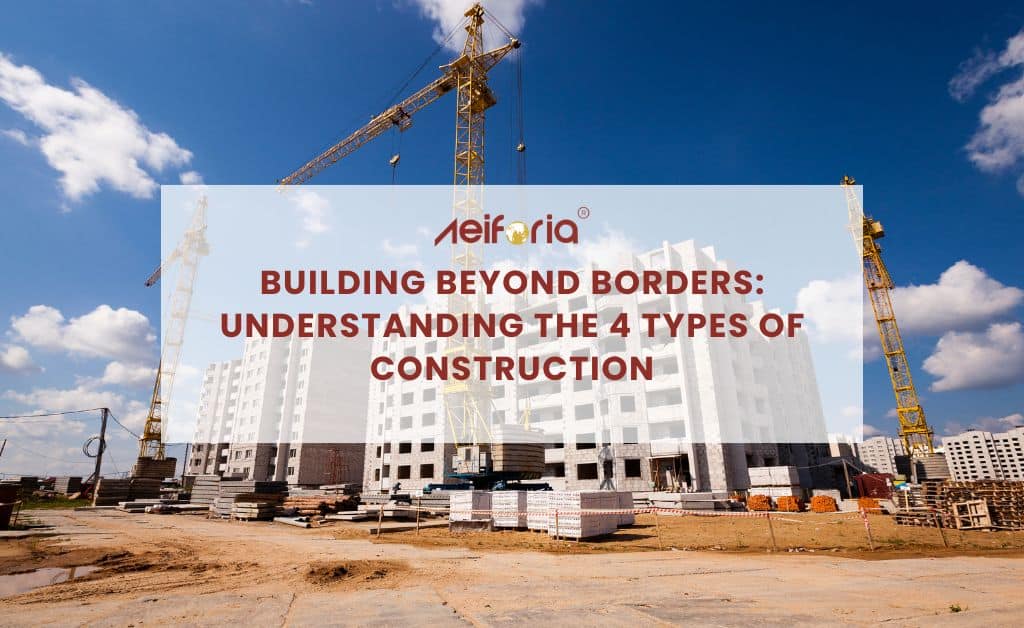
What is Commercial Construction?
Commercial construction refers to building structures intended for commercial purposes, such as office buildings, retail stores, warehouses, hospitals, and other non-residential buildings. Unlike residential construction, commercial construction projects require specialized expertise and equipment to meet the unique demands of these types of buildings.
Commercial construction projects can range from small-scale renovations and remodeling to large-scale projects for new buildings or entire developments. Professional construction companies with specialized teams of engineers, architects, and contractors typically manage these projects.
This article will discuss the different types of commercial construction projects and the various levels of commercial construction.
Common Types of Commercial Construction Projects
- Office Buildings – These structures are designed to accommodate a variety of office spaces and usually feature large open floor plans and multiple levels.
- Retail Spaces – Retail spaces are designed to provide a welcoming environment for shoppers and often feature large windows, attractive storefronts, and ample space for merchandise displays.
- Restaurants – Restaurant construction requires specialized expertise in food service design and layout and plumbing, electrical, and HVAC systems.
- Hotels – Hotel construction projects range from small-scale renovations to large-scale new builds, with specialized features such as elevators, pools, and large conference rooms.
- Educational Facilities – Educational facilities include schools, colleges, and universities and require technological design and construction features to meet the unique needs of students and faculty.
- Healthcare Facilities – Healthcare facilities, including hospitals and clinics, require specialized design and construction features to accommodate the needs of patients and healthcare professionals.
- Sports Facilities – Sports facilities can range from small gyms and fitness centers to large-scale arenas and stadiums, requiring specialized design features and equipment.
- Industrial Buildings – Industrial buildings are designed to accommodate large-scale manufacturing and production operations, requiring technological features such as loading docks, cranes, and heavy-duty electrical and mechanical systems.
Levels of Commercial Construction
Small-Scale Construction
Small-scale construction projects are typically smaller in size and scope than medium and large-scale projects. Examples of small-scale commercial construction projects include the construction of a small retail store, a coffee shop, or a small office building. These projects usually involve less planning and fewer workers than more significant projects. The construction process may involve a general contractor or a construction manager who oversees the project from start to finish.
Example of Small-scale Construction
An example of small-scale commercial construction is the construction of a small retail store. This project typically involves simple designs and minimal structural requirements, such as a concrete slab foundation, steel framing, and simple finishes. The construction process is relatively straightforward and can be completed within a few months.
Medium-Scale Construction
Medium-scale construction projects are larger in size and scope than small-scale projects but smaller than large-scale projects. Examples of medium-scale commercial construction projects include the construction of a mid-sized office building, a hotel, or a restaurant. These types of projects usually involve more planning and coordination than small-scale projects. The construction process may include a team of professional architects, engineers, and contractors who work together to complete the project.
Example of Medium-scale Construction
An example of medium-scale commercial construction is the construction of a mid-sized office building. This type of project typically involves more complex designs and structural requirements, such as reinforced concrete foundations, steel framing, and more sophisticated finishes. The construction process can take up to a year to complete.
Large-Scale Construction
Large-scale construction projects are the largest in size and scope. Examples of large-scale commercial construction projects include the construction of a skyscraper, sports stadiums, or shopping malls. These projects involve extensive planning and coordination and may take several years to complete. The construction process may include a team of architects, engineers, contractors, and subcontractors who work together to complete the project.
Example of Large-scale Construction
An example of large-scale commercial construction is the construction of an airport terminal. This type of project typically involves complex designs and extensive structural requirements, such as reinforced concrete foundations, steel framing, and advanced finishes. It requires the coordination of various stakeholders, such as architects, engineers, contractors, and government officials. The construction process can take several years to complete.
The Process of Commercial Construction
Development and Planning Phase
The development and planning phase is the initial stage of commercial construction. It involves identifying the project's scope, setting the budget, and determining the timeline. The first step is to conduct a feasibility study to determine the project's viability. During this phase, the construction team works closely with clients to understand their needs and preferences.
Feasibility Study
A feasibility study is a critical component of the development and planning phase. It involves assessing the project's feasibility based on various factors such as environmental impact, economic viability, legal and regulatory requirements, and the availability of resources. This study helps the construction team determine whether the project is viable and can be completed within the client's budget and timeline.
Budgeting and Scheduling
Once the feasibility study is complete, the construction team sets the project's budget and timeline. This involves identifying the project's cost and allocating funds for various components such as materials, labor, and equipment. The timeline includes determining the start and end dates of the project and scheduling the multiple phases of construction.
Designing Phase
The designing phase is the next stage of commercial construction. It involves creating the project's design, including the building's layout, size, and appearance. During this phase, the construction team works with architects and engineers to develop the project's blueprint.
Blueprint Development
The blueprint is a crucial component of the designing phase. It includes the project's layout, size, and appearance. The blueprint helps the construction team visualize the final product and identify any potential issues that may arise during construction.
Permits and Approvals
Before construction can begin, the project must obtain various permits and approvals. This involves getting the necessary licenses and permits from the local government and ensuring the project meets all legal and regulatory mandates.
Construction Phase
The construction phase is the most critical stage of commercial construction. It involves the actual building of the project, including excavation, foundation, framing, and finishing.
Excavation and Foundation
Excavation involves removing the soil to create a foundation for the building. The construction team then builds the foundation, supporting the entire building structure.
Framing
After the foundation is complete, the framing phase begins. Framing is like creating the building's skeleton, including the walls, floors, and roof. During this phase, the construction team installs the building's electrical, plumbing, and HVAC systems. To ensure proper installation according to the building plans, having a skilled and experienced team is crucial.
Finishing
Finishing involves completing the building's interior and exterior, including installing drywall, painting, and adding flooring, lighting, and other fixtures.
Final Outcome
The outcome of commercial construction is a completed project that meets the client's needs and preferences. The inspector inspects the building to ensure it complies with all legal and regulatory requirements. The construction team then hands over the building to the client, who can begin using it for its intended purpose.
Difference between Commercial Construction and Residential Construction
Commercial construction differs from residential construction in several ways. The primary difference is that commercial construction involves structures designed for commercial use, such as office buildings, retail stores, and hotels. In contrast, residential construction consists of structures intended for residential use, such as single-family homes, apartments, and condos.
Another significant difference is that commercial construction typically involves more complex building codes and regulations than residential construction. Commercial buildings have higher occupancy rates and require more advanced safety systems than residential ones.
Commercial construction projects are generally more extensive and more complex than residential ones. They often require specialized equipment and materials and skilled laborers with specific training and certifications.
Commercial construction also tends to be more expensive than residential construction. This is due to the higher-quality materials, advanced technology, and specialized expertise required for commercial projects.
Finally, the timeline for commercial construction projects is typically longer than residential projects because commercial buildings often require more planning and coordination and longer lead times for specialized materials and equipment.
Conclusion
In conclusion, commercial construction involves building commercial properties for business purposes. There are different levels of commercial construction, including small-scale, medium-scale, and large-scale construction, each with unique features and requirements. The complete commercial construction process involves careful planning, design, and construction work, from the planning and design phase to the inspection and final touches phase. Commercial construction is a complex process that requires the expertise of professionals in the industry to ensure that it is done right.
FAQs
Why is commercial construction important?
Commercial construction is significant because it provides businesses with the space and infrastructure they need to operate and grow their businesses.
What are the steps involved in commercial construction?
The stages in commercial construction typically include:
- Planning and design.
- Obtaining necessary permits and approvals.
- Site preparation.
- Foundation work.
- Building the structure.
- Finishing the interior and exterior.
What are some common materials used in commercial construction?
Common materials used in commercial construction include concrete, steel, brick, glass, and wood. The specific materials used will depend on the design of the building and its intended use.
What are some factors to consider when planning a commercial construction project?
When planning a commercial construction project, some factors must consider, including the budget, the size and complexity of the building, the location and zoning requirements, the timeline for completion, and any special features or requirements needed.
Why is it essential to hire a reputable commercial construction company?
Hiring a reliable commercial construction firm to guarantee timely and cost-effective project completion while maintaining high-quality standards is crucial. A reputable company will have the expertise, experience, and resources to manage the project effectively and handle any challenges.
If you are looking for a reputable commercial construction company to handle your project, look at Aeiforia. With years of industry experience, Aeiforia has built a solid reputation for delivering high-quality construction services to clients across various sectors. Their skilled professionals, equipped with the latest technology and tools, deliver exceptional results on time and within budget. They have completed projects in multiple industries, from project planning and management to construction and post-construction services. Choose Aeiforia as your commercial construction partner and experience the highest quality and service in the industry.
To learn more about Aeiforia's services and how they can assist with your commercial construction project, don't hesitate to contact their team today!






